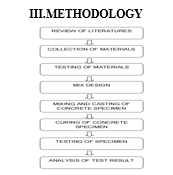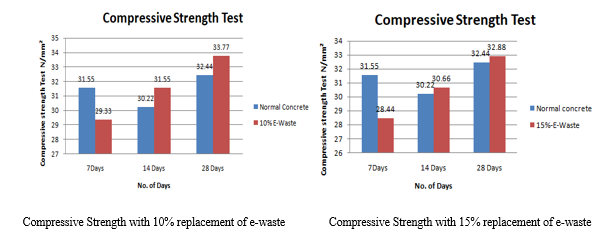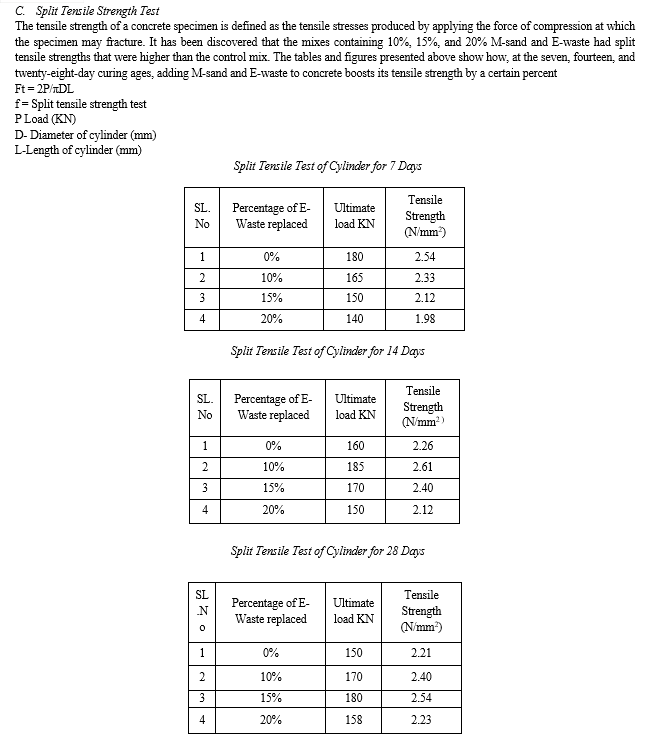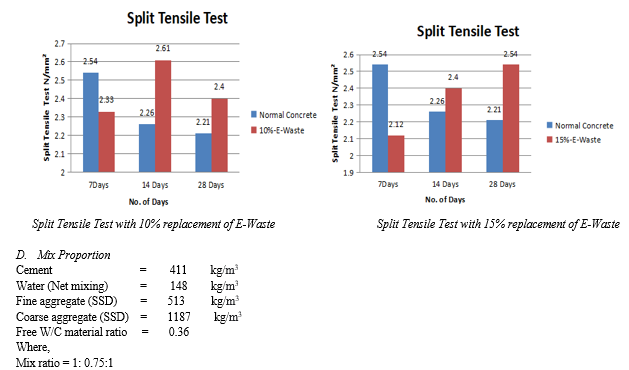Ijraset Journal For Research in Applied Science and Engineering Technology
- Home / Ijraset
- On This Page
- Abstract
- Introduction
- Conclusion
- References
- Copyright
Learning On Concrete Performance Using E-Waste for Partial Coarse Aggregate Replacement
Authors: Mohammed Razin, Madhura Umesh Naik, Hunbait Thubru, Mr. Jayaram Nayak B
DOI Link: https://doi.org/10.22214/ijraset.2024.62460
Certificate: View Certificate
Abstract
Concrete holds a significant position in engineering, and its philosophy may be altered by substituting or adding substances that might prove more practical. This research presents a learning of concrete in which E trash is used to partially replace coarse material. M-30 grade concrete to be used in this project\'s concrete mix design. With the assistance of Indian standard codes according to specification, the qualities and attributes of materials for cement, coarse aggregate, and fine aggregate, and other supplemental components were investigated for concrete mix design. The split tensile strength, compression strength, and different coarse aggregate replacements (0%, 10%, 15%, and 20%) will be examined. M sand will be substituted for fine aggregate.
Introduction
I. INTRODUCTION
Generally speaking, the most common kind is concrete,utilized building material when it comes to infrastructure projects. The term "sustainable concrete" describes concrete whose manufacture has the least negative environmental effects. The process of producing concrete sustainably involves a range of steps, from utilizing alternative materials and procedures to carefully procuring raw resources. Most of the aggregates that are used in concrete originate from from renewable resources including riverbeds, crushed rocks, mine operations, etc. An increase in the need for concrete strains natural resources to the breaking point, upsetting the delicate ecological balance. There's a need to investigate other aggregate sources because the sources that are natural are finite. Alternative aggregates that are being utilized include scrap metal, plastics, rubber, broken glass, and C&D waste. etc. Several benefits include lighter concrete, resistance to water and chemicals, greater durability, better thermal and electrical insulation, etc. But there are also potential drawbacks. These include decreased strength as a result of plastics' worse ability to connect, unsuitability for usage in hot environments like furnaces, expensive handling and recycling costs, decreased workability, etc. The issue of workability can be addressed by the use of the concrete plasticizers. Utilizing leftover materials in the manufacturing of concrete, such as fly ash and e-waste, is appropriately referred to as "green concrete" since it lessens the harm that the creation of concrete's elements does to the environment. Additionally, it facilitates the efficient disposal of garbage, which would not harm the environment otherwise. In order to produce environmentally friendly concrete with a less carbon footprint, we will thus try to include these components into concrete. Concrete's workability improves with the proportion of e-waste it contains. Fly ash with electronic waste concrete is considerably more workable than normal concrete with e-waste. Additionally, they noticed that compressive strength drops when the proportion of e-waste approaches.
II. OBJECTIVES
- To look into the possibility of using e-waste to partially replace coarse aggregate.
- To optimize, through testing, the percentage of e-waste used in concrete to substitute coarse aggregate
- To investigate how M-sand and E-waste affect modified concrete and to contrast E-waste replacement with normal concrete


- Cement
A. Typical Portland cement, or OPC, is the most frequently used binder when building using locally acquired concrete since it is made with IS 269-2015-compliant Jyothi OPC of 43 grade cement.Because of its inexpensive manufacturing costs, this cement is highly sought after in the building sector. They are extensively utilized in the construction of flyovers, bridges, dams, high-rise structures, and roadways. Chemical and physical properties were tested in compliance with IS 4031-1988 and IS 4032-1985.
2. Fine Aggregates
Fine aggregates are made from crushed stone sand using SS crushers that complies with IS 383 - 2016. Crushing hard granite stone yields manufactured sand. The crushed sand has been graded and cleaned to make it suitable as a building material. It has a cubic form with grounded edges. Manufactured sand has a size of less than 4.75mm. They are mostly utilized in the construction sector to produce mortar mixes and concrete.
3. Coarse Aggregates
Coarse aggregates are produced using crushed aggregates using crushers that follow IS 383 - 2016. Crushed stone, mostly in the form of gravel, makes up most of the coarse material that remains in concrete. There are several uses for coarse aggregates in construction. It is most evident when mixed into the concrete mixture.
4. Water
Water has undergone testing in accordance with IS: 3025-1964, which validates the IS: 456 - 2000 standard. Given that its chemical makeup is well-known and controlled, potable water can be used for a variety of purposes, including mixing cement concrete and unadorned cement concrete for use in road construction.
5. Electronic Waste
Electronic trash, or e-waste, is the term used to Abandoned abandoned electrical or electronic equipment. Used electronics meant for recycling, discarding, salvaging, reselling, or repurposing are also considered e-waste.
Material Property Test
- Cement
To assess the physical qualities of the cement used in this inquiry, standard tests were conducted, such as those that measure specific gravity, compressive strength, setting time, and standard consistency. The findings
|
|
PHYSICAL PROPERTIES OF CEMENT |
||
|
S.No |
Description of Tests |
Results |
Limit as per IS 269 / IS 456 |
|
1 |
Standard Consistency test (%) |
31 |
- |
|
2 |
Initial Setting Time test (minutes) |
44 |
30 (Min) |
|
3 |
Final Setting Time(minutes) |
190 |
600 (Max) |
|
4 |
Specific gravity |
3.14 |
3.15 |
2. Fine Aggregates
Fine aggregates, which meet IS 383 - 2016 Standard as Coarse and Fine Aggregates for Organic Sources for Concrete, are formed from stone sand from crushers.
|
SI NO. |
TEST |
RESULT |
|
1 |
Specific Gravity |
2.60 |
|
2 |
Water Absorption (%) |
1.42 |
Here is a description of the fine aggregate sieve analysis test. Remove one kilogram of sand from the test sample. Sieves nos. 10, 4,75, 2.36, 1.18, 0.6, 0.3, and 0.15 should be arranged in the following order: 4.75 at the top and 0.15 at the bottom; cover the top of the sieves. Hold onto the sample in the upper 4.75 sieve. Use the set of sieves to carry out the sifting for at least ten minutes. Determine the sample weight held in each sieve. Tests for impact value, specific gravity, water absorption, and crushing value Outcomes listed below
|
PHYSICAL PROPERTIES OF CEMENT |
|||
|
Sl No |
Description of Tests |
Results |
Limit as per 383 : 2386 |
|
1 |
Specific Gravity |
2.66 |
- |
|
2 |
Water Absorption(%) |
0.55 |
- |
|
3 |
Crusing Value Test (%) |
20.16 |
30 max |
|
4 |
Impact Value Test (%) |
22.27 |
30 max |
3. Coarse Aggregate
The impact, crushing, and sieve analysis tests, as well as other standard tests, were utilized to analyze the physical characteristics of the cement used in this study. The findings are shown in the table below.
|
SI NO. |
TEST |
RESULT |
|
1 |
Impact test(%)
|
20.16 |
|
2 |
Crushing test(%) |
22 |
|
3 |
Sieve analysis |
|
IV. RESULTS ON CONCRETE
A. Test on Freshen Concrete (Slump Test)
- Unsupported fresh concrete flows to the sides and a sinking in height takes place. This vertical settlement is known as slump.
- In this test fresh concrete is filled into a mould of specified shape and dimensions, and the settlement or slump is measured when supporting mould is removed.
- Slump increase as water-content is increased. We check the workability of concrete for different percentage like 10, 15 and 20 %.
|
SI NO. |
Water cement ratio |
Slump (mm) |
|
1 |
0.25 |
6 |
|
2 |
0.30 |
30 |
|
3 |
0.35 |
65 |
|
4 |
0.40 |
130 |
|
5 |
0.45 |
165 |
B. Tests on Hardened Concrete
Compressive Strength Test: Test of Compressive Strength The highest compressive stress a solid material can withstand before cracking under a progressively applied force is known as its compressive strength. In a compression test, the compressive strength is determined by dividing the greatest force by the initial cross-sectional area of the specimen.
Compressive strength Test for Cube 7 Days
|
SL.No |
Percentage of E-Waste replaced |
Ultimate load KN |
Compressive Strength(N/mm2) |
|
1 |
0% |
740 |
32.88 |
|
2 |
10% |
660 |
29.33 |
|
3 |
15% |
640 |
28.44 |
|
4 |
20% |
560 |
24.88 |
Compressive strength Test for Cube 14 Days
|
SL.No |
Percentage of E- Waste replaced |
Ultimate load KN |
Compressive Strength(N/mm2) |
|
1 |
0% |
680 |
30.22 |
|
2 |
10% |
710 |
31.55 |
|
3 |
15% |
690 |
30.66 |
|
4 |
20% |
500 |
22.22 |
Compressive strength Test for Cube 28 Days
|
SL.No |
Percentage of E- Waste replaced |
Ultimate load KN |
Compressive Strength(N/mm2) |
|
1 |
0% |
720 |
32.00 |
|
2 |
10% |
740 |
32.88 |
|
3 |
15% |
700 |
31.11 |
|
4 |
20% |
660 |
29.33 |



V. ACKNOWLEDGEMENTS
We want to express our gratitude to our guide, Mr. Jayaram Nayak B, Assistant Professor, Department of Civil Engineering, from the bottom of our hearts for all of his help and support during this project.
We thank H.H. Shri Vishwavallabha Theertha Swamiji for his blessings to this institution. We are indebted to Prof. Dr. Thirumaleshwara Bhat, Principal and Prof. Dr. Ganesh Aithal, Vice Principal, for their recommendations and counsel at different points along the project. We also extend our heartfelt gratitude. to Dr. Deepika B V for her assistance.
We extend our thanks to the Management of Shri Madhwa Vadiraja Institute of Technology and Management, Bantakal, Udupi for providing good laboratory and library facilities. We also remain grateful to the co-operation and help rendered by the both instructional and support staff of the Civil Engineering Department.
Lastly, we take this opportunity to offer our regards to all of those who have supported us directly or indirectly in the accomplishment of this project successfully.
Conclusion
1) In concrete, replacing coarse aggregate with 10%, 15%, or 20% shows promising results, particularly the 10% replacement. 2) When considering normal concrete, both partial replacement and slump yield similar strengths. 3) A 10% replacement in concrete yields good strength, according to test findings on both fresh and hard concrete. 4) In both compression and split tensile tests, the results indicated that e-waste replacement in concrete can be utilized. 5) In concrete, e-waste works well as a partial substitute for coarse aggregate both when it\'s new and after it\'s hardened. When compared to greater quantities, it shows superior strength and workability at lower replacement volumes. 6) Millions of tons of e-waste are created annually across the world.Making use of e-waste can help save the environment. Concrete strength can be increased by up to 10% by substituting modest amounts of e-waste for coarse aggregate. 7) There is a significant chance that e-waste could eventually replace part of the coarse components in concrete. The use of e-waste in lieu of coarse material in concrete greatly increases its compressive strength. 8) The test findings indicated which percentages of e-waste substitution produced better results than regular concrete, especially in terms of split tensile strength and compressive strength. 9) Even at 10% replacement, there is an observable increase in split tensile strength, suggesting a significant impact of e-waste on this property
References
[1] Rashidul Islam, Tasnia Hassan Nazifab, AdhiYuniarto, A.S.M. ShanawazUddin,SalmiatiSalmiati, Shamsuddin Shahid (2019). An empirical study of construction and demolition waste generation and implication of recycling. Waste management-Elsevier 95:10-21, https://doi.org/10.1016/j.wasman.2019.05.049. [2] ShahironShahidan, MohamadAzim Mohammad Azmi, Kumanan Kupusamy,Sharifah Salwa MohdZuki, Noor wirdawatiAli(2017) Utilizing Construction and Demolition (C&D) Waste as Recycled Aggregates (RA) in Concrete. Procedia Engineering-Elsevier 174:1028– 1035, https://doi:10.1016/j.proeng.2017.01.255. [3] Ahmed Shaban Abdel-Hay (2017) Properties of recycled concrete aggregate under different curing conditions. HBRC Journal-Elsevier13: 271- 276, and engineering: Volume 2019, Article ID 7605098, 7 pages. [4] Jan Pizo, 9i8hyugtfvcdn Go?aszewski , Mohamed Alwaeli and Patryk Szwan (2020) Properties of Concrete with Recycled Concrete Aggregate Containing Metallurgical Sludge Waste. Materials-MDPI, 13, 1448,http://dx.doi.org/10.3390/ma13061448. [5] IvetaNováková, KarelMikulica (2016) Properties of concrete with partial replacement of natural aggregate by recycled concrete aggregates from precast production. Procedia Engineering 151:360 367.http://dx.doi:10.1016/j.proeng.2016.07.387. [6] Mohana doss Ponraj, AmirrezaTalaiekhozani, RosliMohamadZin, MohammadIsmail, Muhd Zaimi AbdMajid, AliKeyvanfar, Hesam Kamyab (2015). BioconcreteStrength, Durability, Permeability, Recycling and Effects on Human Health: A Review.Proc. of the Third Intl. Conf. Advances in Civil, Structural and Mechanical Engineering, Institute of Research Engineers and Doctors, USA http://dx.doi:10.15224/ 978 -1-63248-062-0-28. [7] Rafat Siddique, Jamal Khatib, Inderpreet Kaur, “Use of recycled plastic in concrete :A review” Waste Management 28 (2008) [8] Ashwini Manjunath B.T, “Partial Replacement of EPlastic Waste as Coarse Aggregate in Concrete” Procedia Environmental Sciences 35 (2016), 731-739 [9] S.Vanitha, V.Natrajan, M.Praba, “Utilisation of Waste Plastics as a Partial Replacement of Coarse Aggregate in Concrete Blocks” Indian Journal ofScience and Technology, Volume 8 (12), June 2015 [10] Pravin A. Manatkar, Ganesh P.Deshmukh, “Use of non – metallic E-Waste as a Coarse Aggregate in a Concrete” International Journal of Research in Engineering and Technology, Volume 04, Issue 03, March 2015.
Copyright
Copyright © 2024 Mohammed Razin, Madhura Umesh Naik, Hunbait Thubru, Mr. Jayaram Nayak B. This is an open access article distributed under the Creative Commons Attribution License, which permits unrestricted use, distribution, and reproduction in any medium, provided the original work is properly cited.

Download Paper
Paper Id : IJRASET62460
Publish Date : 2024-05-21
ISSN : 2321-9653
Publisher Name : IJRASET
DOI Link : Click Here
 Submit Paper Online
Submit Paper Online

